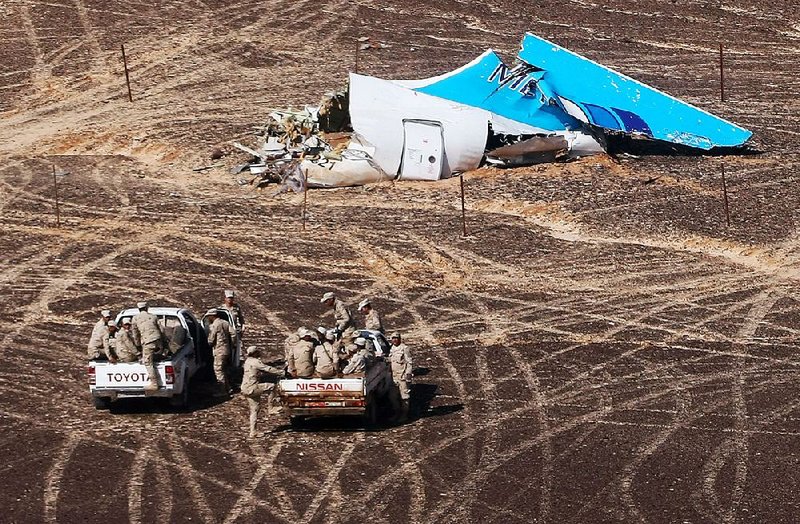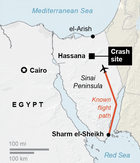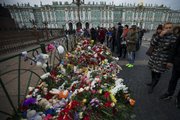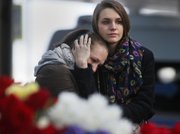ST. PETERSBURG, Russia -- Only an external impact could have caused a Russian plane to dive into the Egyptian desert, killing all 224 people on board, its Russian operator said Monday, adding to a series of confusing statements from investigators that left unclear why the plane broke up in midflight.
Russian aviation officials called the airline's assertion premature.
Some aviation experts raised the possibility that a bomb on board the Metrojet Airbus A321-200 brought it down, while others cited an incident in 2001 when the aircraft grazed the runway with its tail while landing.
James Clapper, the U.S. director of national intelligence, said that while there is no direct evidence of any terrorist involvement yet, it couldn't be excluded that the plane was brought down by Islamic State extremists in the Sinai Peninsula.
"It's unlikely, but I wouldn't rule it out," he told reporters in Washington.
Asked if a terrorist attack could be ruled out, President Vladimir Putin's spokesman, Dmitry Peskov, said, "No versions could be excluded."
The Metrojet plane was flying at 31,000 feet over the Sinai when it crashed Saturday, 23 minutes after taking off from the Egyptian Red Sea resort of Sharm el-Sheikh for St. Petersburg with mostly Russian passengers.
Metrojet firmly denied that the crash could have been caused by either equipment failure or crew error.
"The only possible explanation could be an external impact on the airplane," Metrojet's deputy director Alexander Smirnov told a news conference in Moscow. When pressed for more details, Smirnov said he was not at liberty to discuss them because the investigation was ongoing.
Viktor Yung, another deputy director general of Metrojet, said the crew did not send a distress call and did not contact traffic controllers before the crash.
Egyptian officials have offered conflicting accounts on whether or not the plane issued any distress calls.
But Russia's top aviation official, Alexander Neradko, dismissed the company's statement as premature and unfounded.
In televised comments from Egypt, Neradko said it would be possible to draw conclusions about the crash only after experts examine the plane's flight data and cockpit voice recorders and study the wreckage.
He said the large area where debris was scattered indicated the jet had broken up at high altitude, but he refrained from citing a reason for the crash pending the investigation.
Neradko also said Egypt was keeping tight control over data from the flight recorders and other instruments.
"The Egyptian commission is conducting the investigation, and is giving no records and transcripts, be it of the flight recorders or on-ground recorders or radar data, to anyone," he said.
Specialists from France, where Airbus is based, may have to help Egypt analyze the recorders, Neradko said, adding that one of the devices had suffered some damage.
Islamic State claim
A local affiliate of the extremist Islamic State group has claimed it brought down the aircraft, which crashed in the northern Sinai where the Egyptian military and security forces have battled militants for years. Both Egyptian and Russian officials have dismissed that claim as not credible.
Still, the U.S., Germany and Britain all had overflight warnings in place for the Sinai. They advised airlines to avoid flying over the peninsula below 26,000 feet and to avoid the Sharm el-Sheik airport because of extremist violence and the use of anti-aircraft weapons.
British military analyst Paul Beaver said he thought the crash was most likely caused by a bomb on board, because the Islamic State hasn't been known to possess surface-to-air missile systems capable of striking passenger planes at cruising altitude.
Beaver added that the Sinai desert is well-scrutinized by intelligence agencies, so a missile system would have been seen.
Robert Galan, a French aviation expert, said Metrojet's claim of an "external impact" pointed to two possibilities: a bomb or sabotage.
Sabotage would require familiarity with the electrical or fuel systems of the A321-200, but hiding a bomb would need less knowledge, he added.
Galan said an analysis of the plane's data and voice recorders -- the "black boxes" -- will not confirm either a bomb or sabotage, as it records only the pilots' communications and technical readings. But he said investigators could know within 48 hours whether a bomb downed the jet because the debris would show traces of explosives.
The plane's operator has a spotty safety record and was rebranded recently after another deadly accident. The airline, registered as Kogalymavia, changed its trade name to Metrojet after one of its Tu-154 jetliners caught fire in 2011 while taxiing before takeoff, killing three people and injuring more than 40 others.
The Airbus A321-200 that crashed Saturday was built more than 18 years ago and had several operators before entering Metrojet's fleet in 2012.
One area investigators will look at closely is whether the tail separated from the rest of the plane in flight as the result of damage caused by a 2001 incident in Cairo, in which the tail struck the runway during a landing, said aviation safety consultant John Cox. Such "tail strikes" can cause extensive damage to the aircraft's skin around the rear lavatories and galley.
Andrei Averianov, Metrojet's deputy director for engineering, ruled out the tail strike as a possible factor during the company's news conference.
"I am absolutely confident that this incident could not be the reason for what has happened because the plane was repaired by its manufacturer," Averianov said. "Airbus has developed special technology for such repairs which guarantees the usage of such an airplane."
Cox said monthly maintenance checks typically can't spot a return of damage from a tail strike because the cracks are inside the plane in an area that's not normally accessible during visual inspections.
Instead, tail strike repairs are examined during heavy maintenance checks that typically take place about every four to five years, he said. Investigators will "look not only at whether the repair [was] done properly, but were the inspections of the repair done on a regular basis during the normal heavy maintenance checks," Cox said.
At the crash site in the Sinai, emergency workers and aviation experts from Russia and Egypt searched for more bodies and examined the debris.
Teams finished combing a 7.7-square-mile area for bodies by afternoon and expanded the search to an 11.6-square-mile area. Russian Emergency Situations Minister Vladimir Puchkov promised they will not rest until all victims' remains are found.
Investigators from France and Germany, representing Airbus, and from Ireland, where the plane was registered, were to join investigators in Egypt.
The team could include authorities from U.S. because the plane's engines were made by a group led by United Technologies Corp.'s Pratt & Whitney arm.
White House press secretary Josh Earnest said the U.S. offered support for the investigation, but he added that he's not aware of any resources that have been dedicated to it so far.
Bodies flown to Russia
A Russian government plane carried 130 bodies and partial remains to St. Petersburg on Monday. The victims' bodies were taken to St. Petersburg's main morgue, and morgue officials began working to identify the victims with the help of DNA samples and relatives. Another plane of remains was scheduled for today.
The greatest number of the victims by far were from St. Petersburg, Russia's second-largest city.
Relatives congregated in a ho tel near the airport, awaiting word of when they would be called to the morgue.
Larisa Pulyanova and Anatoly Pulyanov were there to identify their only son, Roman Pulyanov, 29, who had been on vacation with his girlfriend.
Tears welling, Larisa Pulyanova remembered her son as "young and tall and handsome."
He had picked this vacation, she said, because a week for two cost only $565, and the couple did not want to spend more because they were saving for their wedding.
Relatives, friends and colleagues have piled bouquets and mementos at St. Petersburg's Pulkovo Airport, where the plane had been expected to land. Others paid homage at the historical city's Palace Square, where photos of victims dangle from a fence.
Images posted on social networks by many of the Russian vacationers mark the last public record of their lives.
Ten-month-old Darina Gromova was the accident's youngest victim. In a photo her mother, Tatyana, posted online from Pulkovo Airport before they left for Egypt, she stands on a windowsill, leaning on an airport window transfixed by planes below.
Her grandmother, Elena Gromova, told Russian news site Life News 78 that she offered to keep the baby home for the Egypt trip, but her parents said no.
"They wanted to take the child with them, to let her splash her feet in the sea," Gromova was quoted as saying.
Olga Sheina posted a photo of her 3-year-old daughter, Anastasia, and husband, Yuri, on VKontakte as they boarded the plane meant to take them home. Anastasia has one arm around her father's neck as they mount the stairs to the plane.
Elena Rodina and Alexander Kotov were married exactly a year ago. Marking their anniversary in Egypt, they posted photos online of the sea, the beach, their hotel. The day after the crash, Rodina would have turned 35.
Information for this article was contributed by Dmitry Lovetsky, Vladimir Isachenkov, Nataliya Vasilyeva, Katherine Jacobsen, Joan Lowy, Ken Dilanian, Lori Hinnant, Jill Lawless, Irina Titova and Angela Charlton of The Associated Press; by Neil MacFarquhar, Andrew E. Kramer, Alexandra Odynova, Nicola Clark, Keith Bradsher, Eric Schmitt, Kareem Fahim and Rick Gladstone of The New York Times; and by Alan Levin, Andrea Rothman and Andrey Lemeshko of Bloomberg News.
A Section on 11/03/2015



